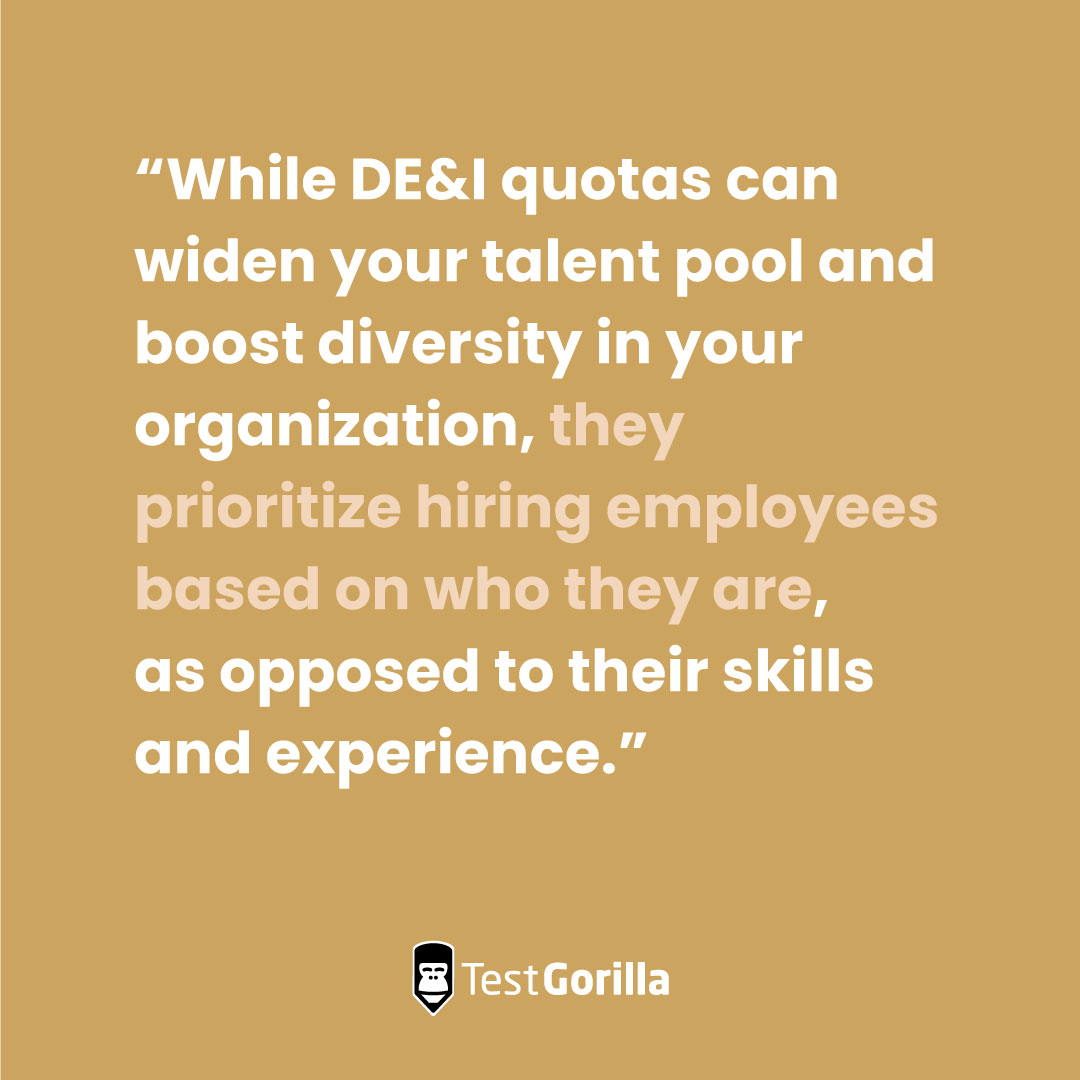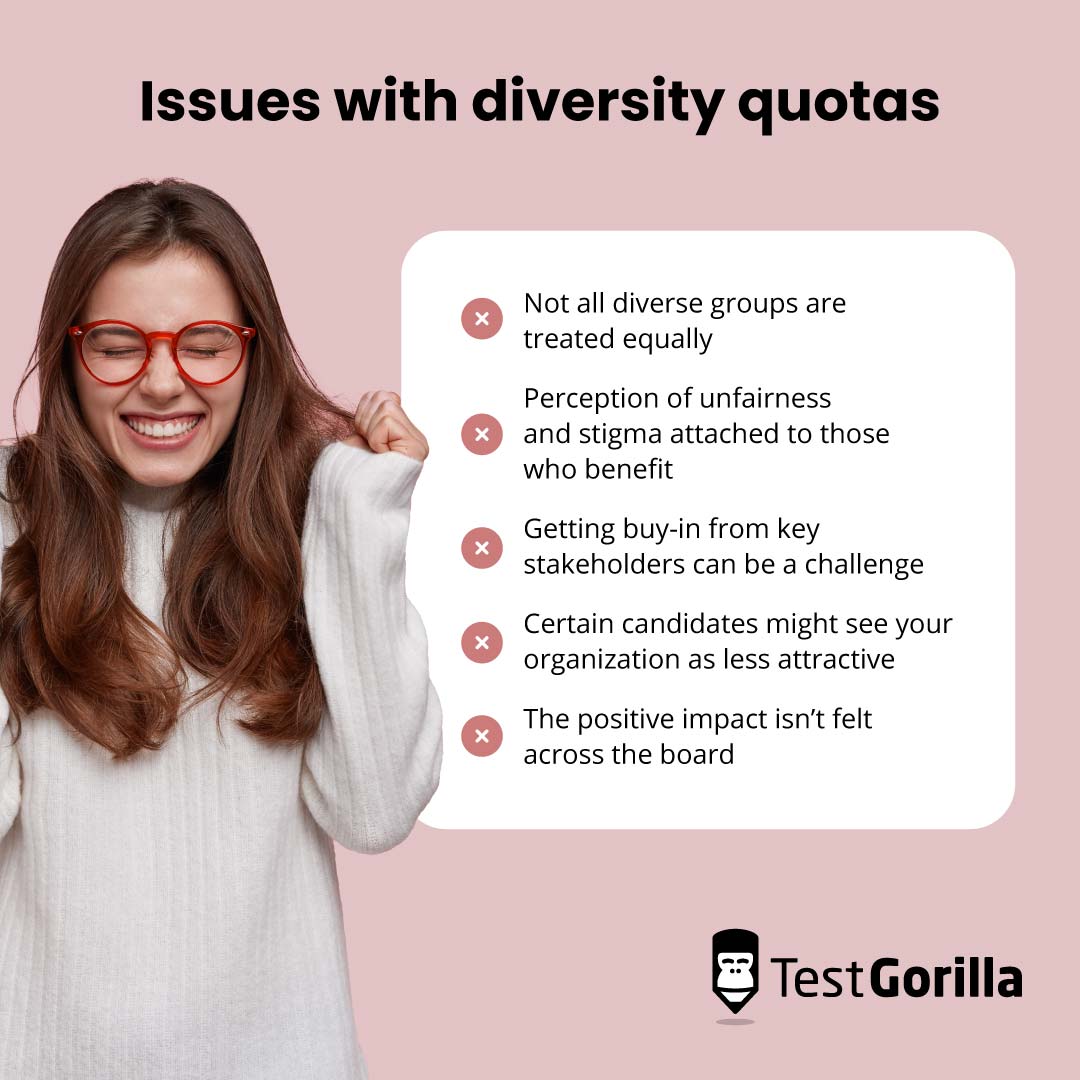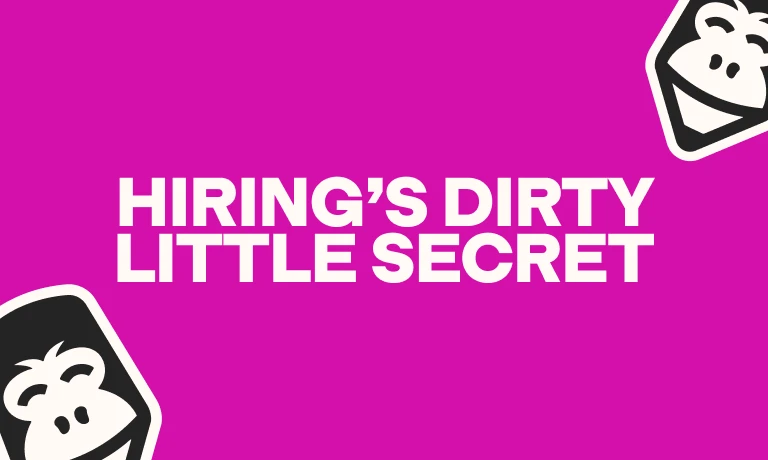After onboarding Antonio, your newest tech hire, you're excited to report to your leadership team that you're one step closer to fulfilling your company's diversity, equity, and inclusion (DE&I) quota. It’s part of a push to make your organization more diverse in light of growing awareness of the positive impact on innovation, employee morale, and overall business success.
However, after a few weeks on the job, you notice Antonio's skills on paper don't match his expertise in real life. He’s struggling to keep up with his team, who have begun referring to him as "the diversity hire." The implication being: that’s the only reason he was hired.
This isn't exactly helping Antonio's performance or team morale.
While DE&I quotas can widen your talent pool and boost diversity in your organization, they prioritize hiring employees based on who they are, as opposed to their skills and experience. Therefore, you need a multifaceted approach to improving the quality and diversity of your workforce.
In this post, we’ll explore the pros, cons, and controversies around quotas and attempt to answer the question “Do they still work?”
We’ll also look at how skills-based hiring can help mitigate concerns about quotas as well as increase diversity at all levels.
How quotas positively impact diversity
Research shows that diverse teams outperform non-diverse ones financially.
With diversity in background and skills, you get diversity in perspectives. This can lead to more creative problem solving, improved employee satisfaction, and a dynamic company culture people want to be part of.
This is why so many companies are now keen to have diversity programs, some of which may include quotas, to get employees from underrepresented groups through the door.
Next, let’s explore how quotas positively affect diversity, and why it's a key focus.
Encouraging equal representation
Quotas provide a specific benchmark for hiring that organizations strive to meet, reducing ambiguity and creating a transparent framework for increasing diversity.
By reaching quotas, you can demonstrate your organization's commitment to fostering equal representation. Moreover, you can create a more inclusive environment where individuals from all backgrounds have a fair opportunity to contribute to the company's success.
This is especially important since 83% of millennial employees are actively engaged at work when they believe their organization fosters an inclusive culture. This drops to 60% for non-inclusive organizations.
Creating accountability
Quotas hold leaders and decision-makers accountable for progress toward diversity goals. When these targets aren't met, it becomes evident that further action is required to address representation imbalances. This can help create a checks and balances system where you're continually improving DE&I strategies to build a diverse workforce.
Reflecting customer base
For companies with diverse customer bases, quotas help ensure their workforce better represents the demographics of their clients. This can enhance customer relationships and improve your ability to meet their needs.
Case study: Microsoft and diversity targets
Microsoft has made several commitments to increase the representation of underrepresented groups in its workforce. According to its 2021 Diversity and Inclusion report, it pledged to double the number of Black employees in senior leadership roles by 2025.
With transparency, commitment, and a focus on creating an inclusive culture, Microsoft has made steady progress in increasing diversity and inclusion of various groups. By doing so, it's ensuring that diversity quotas are more than just compliance measures and truly contribute to a diverse and equitable workplace long-term.
Issues with diversity quotas
Now that you know how quotas benefit diversity, let's take a look at how diversity quotas can negatively impact your employees and company – and actually hinder DE&I.
Not all diverse groups are treated equally
While diversity quotas can increase equal representation by setting clear, numerical targets for underrepresented groups within an organization, what happens when targets aren't the same across minority groups?
For example, gender quotas favoring women and Black employees appear to be more common than quotas for disabilities. Moreover, in the US, many diversity quotas are seen as unconstitutional due to equal protection provisions guaranteeing that no one will be treated differently because of their gender, race, ethnicity, or other fundamental characteristics.[1]
Therefore, it's up to the company, not the government, to focus on changing their hiring and promoting practices to reflect an equal representation of people, which doesn't always happen.
Perception of unfairness and stigma attached to those who benefit
Quotas are a quick fix to boosting diversity in companies. However, they carry the risk of categorizing people by their differences – seeing them for what they represent rather than the individuals they are. This can cause resentment among existing employees who may feel they have to outcompete other applicants on competencies alone.
In Antonio’s case, his team felt slighted because he landed a competitive position due to who he is, not how good he is at his job. This can create a less-than-ideal dynamic where people feel superior to the "diversity hires" on their team, even if they possess the right skills and competencies for the job.
If left unaddressed, this friction can result in a psychologically unsafe environment and can lead to burnout, lack of engagement, and loss of morale.
Additionally, diversity quotas can inadvertently reinforce negative stereotypes about underrepresented groups by implying that these individuals need special treatment to succeed.
Getting buy-in from key stakeholders can be a challenge
Change, especially when it challenges the status quo, can be met with resistance. Key stakeholders who are accustomed to the existing systems and culture may be hesitant to embrace diversity quotas. This is because they represent a significant shift in the organization's practices. For instance, trying to promote a woman to an all-male board.
Additionally, in cases where diversity quotas extend to leadership positions, existing leadership may see it as a threat to their positions or question whether they are being targeted for replacement.
Certain candidates might see your organization as less attractive
Strong candidates might feel that their advancement at your company is dependent on their race, gender, or disability status, which can deter them from applying to begin with. Without a system for mitigating bias, like talent assessments that focus on measuring skills, employees can’t be sure if they're being promoted or hired for the right reasons.
This can create a lack of trust in hiring managers and leadership, especially if diversity quotas are managed and communicated poorly. For instance, it should be made clear that your diversity quota isn't just about hiring people based on who they are. It's about making sure the recruitment and promotion process is free from bias and reflective of a diverse talent pool.
The positive impact isn’t felt across the board
Even with diversity quotas in play, you still might not experience the benefits of diverse leadership. This is because it's easy to focus diversity efforts on entry-level positions while the makeup of executive teams remains unchanged.
There's a reason it's called DE&I: Without equity and an inclusive culture, any quota system is doomed to fall short at diversity only. This fails to achieve true representation at all levels.
Next, we’ll look at how skills-based hiring can overcome the negative impacts of diversity quotas. Additionally, how you can combine the two to create a truly inclusive culture from the ground up.
The best insights on HR and recruitment, delivered to your inbox.
Biweekly updates. No spam. Unsubscribe any time.
How skills-based hiring combats quota cons
Skills-based hiring involves testing candidates on skills they have and those that can be taught, early in the application process.
By measuring soft, hard, and transferable skills, you can assess everyone objectively on equal footing regardless of where they come from or their educational or work history. Plus, you get a clear understanding of their potential and ability to succeed in the role when you test for things like job motivation.
Skills-based hiring can, therefore, alleviate concerns about perceived unfairness that can come with diversity quotas. When candidates and employees know they're evaluated solely on skills, it reduces the perception that diversity quotas favor one group over another.
While quotas can be a useful tool to jump-start diversity initiatives, they shouldn't be the sole strategy. Combining them with skills-based hiring ensures you're not only achieving diversity but also fostering a workplace where individuals from underrepresented groups are truly valued for their skills and qualifications. Thus creating a more equitable and genuinely inclusive environment.
Below, we explore how you can do this.
How to use skills-based hiring and quotas together to boost DE&I
Whether you're wedded to quotas or want to scrap them, you can use skills-based hiring to foster diversity at all levels while ensuring fair treatment of all candidates.
This approach lets you combat the downsides of diversity quotas because employees are hired or promoted entirely based on their skills. Adopting skills-based hiring makes it easier to get stakeholder buy-in, create an inclusive culture, and get everyone feeling the positive impact of a diverse workplace. Plus, it's harder to stigmatize someone who took a skills test to get the job if you all have to.
Let's take a look at how you can use skills-based hiring to supplement or replace your current diversity initiatives.
Conduct a skills-gap analysis
A skills-gap analysis involves assessing the current skills in your workforce and pinpointing the ones you need to stay competitive.
When you hire for specific skill sets, new hires are more readily accepted by the team because they offer an immediate and tangible benefit to them. This negates any potential issue of employee resentment toward "diversity hires."
Once you've done your analysis, you can compare the skills and qualifications of underrepresented groups with those of the majority population in your workforce. This analysis will help identify disparities in skills and qualifications that may be hindering equal representation.
Implement blind hiring processes
Blind hiring practices like removing candidate information from job applications can help mitigate unconscious bias and improve your ability to make objective recruiting decisions.
In the landmark study, Are Emily and Greg more employable than Lakisha and Jamal? researchers found that American-sounding names received 50% more callbacks for interviews than African-American ones.[2] Considering each resume was exactly the same, it's hard to deny bias exists in hiring.
With a skills-based approach to hiring, you can blindly identify the best talent–irrespective of background–and encourage a culture of meritocracy for long-term inclusion. According to our 2024 State of Skills-Based Hiring report, 90% of employers using skills-based hiring claim it has a positive impact on diversity.
Use talent assessments for internal mobility
Talent assessments aren't just useful for hiring: They let you reskill and upskill current employees by helping you spot any skills gaps and measuring progress. This lets you improve internal mobility in your company and retain more skilled talent, saving you time and the costs involved in high employee turnover.
By training diverse employees and developing their skills, you can improve diversity in representation at all levels, including leadership.
Assessments like the Motivation test and the Leadership and People Management test are just a few ways to identify and promote aspiring leaders.
Once you start administering talent assessments, make sure to regularly review their effectiveness in achieving diversity goals or quotas. This includes analyzing assessment results to identify any potential disparities in outcomes for different demographic groups. For example, you might realize that people with a learning disability need more time to complete their tests or have the option to answer questions verbally.
Pro tip: TestGorilla's talent assessment software lets you provide reasonable accommodations to candidates when administering skills tests. Check out our post for more information on how talent assessments create equal opportunities when hiring people with disabilities.
Diversity quotas 🤝 Skills-based hiring
In essence, the answer to the question: "Do diversity quotas still work?" is yes. However, if done poorly, and with a focus on results and numbers instead of process, culture, and true inclusion, they can lead to problems.
Used poorly, quotas can quickly undo any advantages you get from increasing representation on your teams. This is because there's a perception of unfairness and stigma attached to those who benefit, the positive impact isn't felt across the board, and not all groups are treated equally.
However, by combining diversity quotas with a skills-based approach to hiring, you can create a powerful strategy that covers all your bases. Talent assessments let you hire, upskill, and promote diverse talent that’s earned a place in your organization based on what they can do, not who they are.
This lets you create a truly inclusive culture where all your employees feel respected and supported.
Hire diverse teams, get the skills you need. With skills-based hiring, you get the best of both worlds. Download the 2024 State of Skills-Based Hiring report to learn more |
Sources:
"Mandated Quotas Won’t End Inequalities In Business Leadership." (2022). Forbes. Retrieved October 26, 2023. https://www.forbes.com/sites/andiekramer/2022/06/23/mandated-quotas-wont-end-inequalities-in-business-leadership/?sh=77031b2161ab
“Are Emily and Greg More Employable than Lakisha and Jamal? A Field Experiment on Labor Market Discrimination.” (2003). National Bureau of Economic Research. Retrieved October 26, 2023. https://www.nber.org/papers/w9873
Related posts
You've scrolled this far
Why not try TestGorilla for free, and see what happens when you put skills first.





















